Euro 2016 was the first time a European Championship was held without the Netherlands, with the side failing to qualify for the tournament just two years after reaching the semi-finals of the World Cup in Brazil. Their road back has not been easy, with the side missing out on the World Cup in 2018 as well but finally, they are back to fight for an international trophy.
The side has seen five different managers since their last major tournament, the World Cup in 2014, after which Louis van Gaal stepped down. Guus Hiddink, Danny Blind and Dick Advocaat could not steer the squad to success on the international stage but with Ronald Koeman, there was a real sense of progress. The side reached the finals of the UEFA Nations League, where they narrowly lost to Portugal, and the future was looking bright for the Dutch, with some exciting talents lighting up the stage under Koeman’s leadership. Although Koeman’s contract was set to run all the way up to the 2022 World Cup, Barcelona came knocking and poached the manager that had successfully guided them back to the Euros. This made way for the current manager, Frank de Boer, to assume managerial duties.
The selection did cause some stir among fans, and rightly so, with de Boer’s recent record as manager prior to the announcement indeed poor. Despite four consecutive titles at Ajax early in his career, what followed were poor stints at Inter, where he lasted just 85 days, and Crystal Palace, where he was manager for just seven games. There was a revival of sorts when he moved to the MLS with Atlanta United, where he won two trophies in his first season but a dip towards the latter stages once again saw him leave. His stint so far as the manager of the national side has been unconvincing as well. Despite just one loss, de Boer has won just half of the eight games that he has managed, with the remaining three being draws. With a talented squad at his disposal, the majority are still unsure about how the Netherlands will fare on their return and in this tactical analysis, we take an in-depth look at the Dutch squad ahead of the Euros.
THE SQUAD
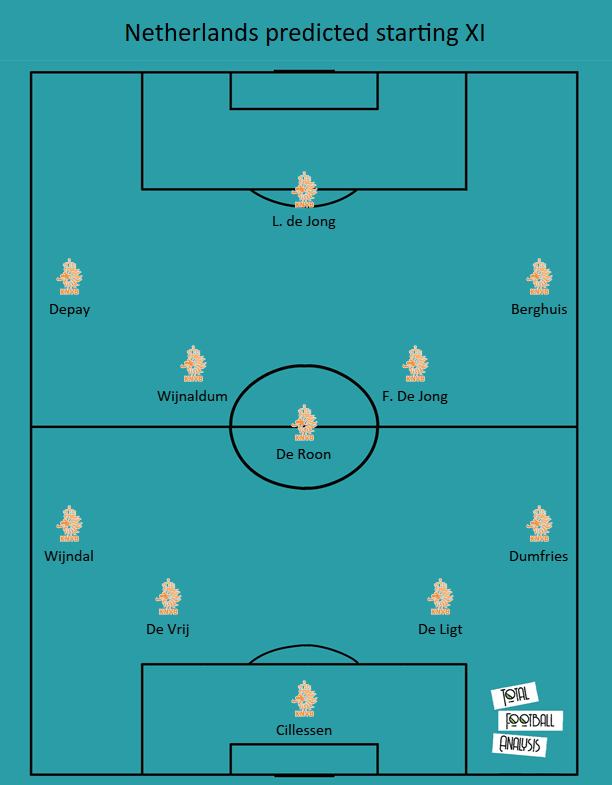
It has become clear that de Boer’s preferred formation is the 4-3-3 and we expect this to continue in the Euros as well. The Dutch have an aging goalkeeping unit, with the three that were initially selected for the previous round of fixtures, Jasper Cillessen, Tim Krul, and Maarten Stekelenberg all 30. While Cillessen withdrew from the squad early due to injury with Krul taking his place, he has already begun playing for Valencia and should take his place between the sticks at the Euros.
Key player and captain Virgil van Dijk is still recovering from a cruciate ligament injury suffered way back in October and will miss the Euros this time around. This isn’t the only worry for de Boer in the center-back position though, with Daley Blind also currently recovering from an ankle injury suffered in the Netherlands’ 7-0 victory over Gibraltar at the end of March that required surgery. Blind has made the squad though and so we should expect him to feature at the tournament. Apart from this, we expect the first choice pairing to be Stefan de Vrij and Matthijs de Ligt.
In midfield, Frenkie de Jong and Georginio Wijnaldum are sure starters barring injuries, with the latter the captain in the absence of van Dijk. The form and consistency of the pair will be crucial to the side’s campaign and could very well be a deciding factor in how far the side progresses. While there may be calls for Davy Klaassen to start along with the pair, we believe it will be Marten de Roon who completes the midfield three. In the bigger games, de Boer has often preferred de Roon in order to offer more protection for the defense and we believe that the manager will opt for a more conservative approach, playing Wijnaldum in a more attacking role with de Roon, and not de Jong, to play the more defensive role. This of course offers de Jong more freedom in midfield as well.
Upfront, Steven Berghuis, and Memphis Depay are pretty much guaranteed starters down the right and left flank respectively. Berghuis has performed well when called upon for the side this season and three consecutive starts in the previous international break show de Boer’s growing confidence in him. Depay is a key figure for the side in attack and de Boer has shown that he prefers to play him down the left where he can showcase his creativity more than down the middle. Moreover, owing to de Boer’s style of play, we expect him to opt for Luuk de Jong over Donyell Malen through the middle to pose a greater threat from crosses into the box. Wout Weghorst is also a good option and has made the squad but it does seem like de Boer is not fully convinced about him just yet, which is why we feel Luuk de Jong gets the nod.
This Netherlands side boasts talent but unfortunately does have a fair share of inexperience as well and its shallow defense may prove to be an issue should they go deep into the tournament. However, on paper, the starting lineup does look good for the squad to at least pose some challenges in the tournament.
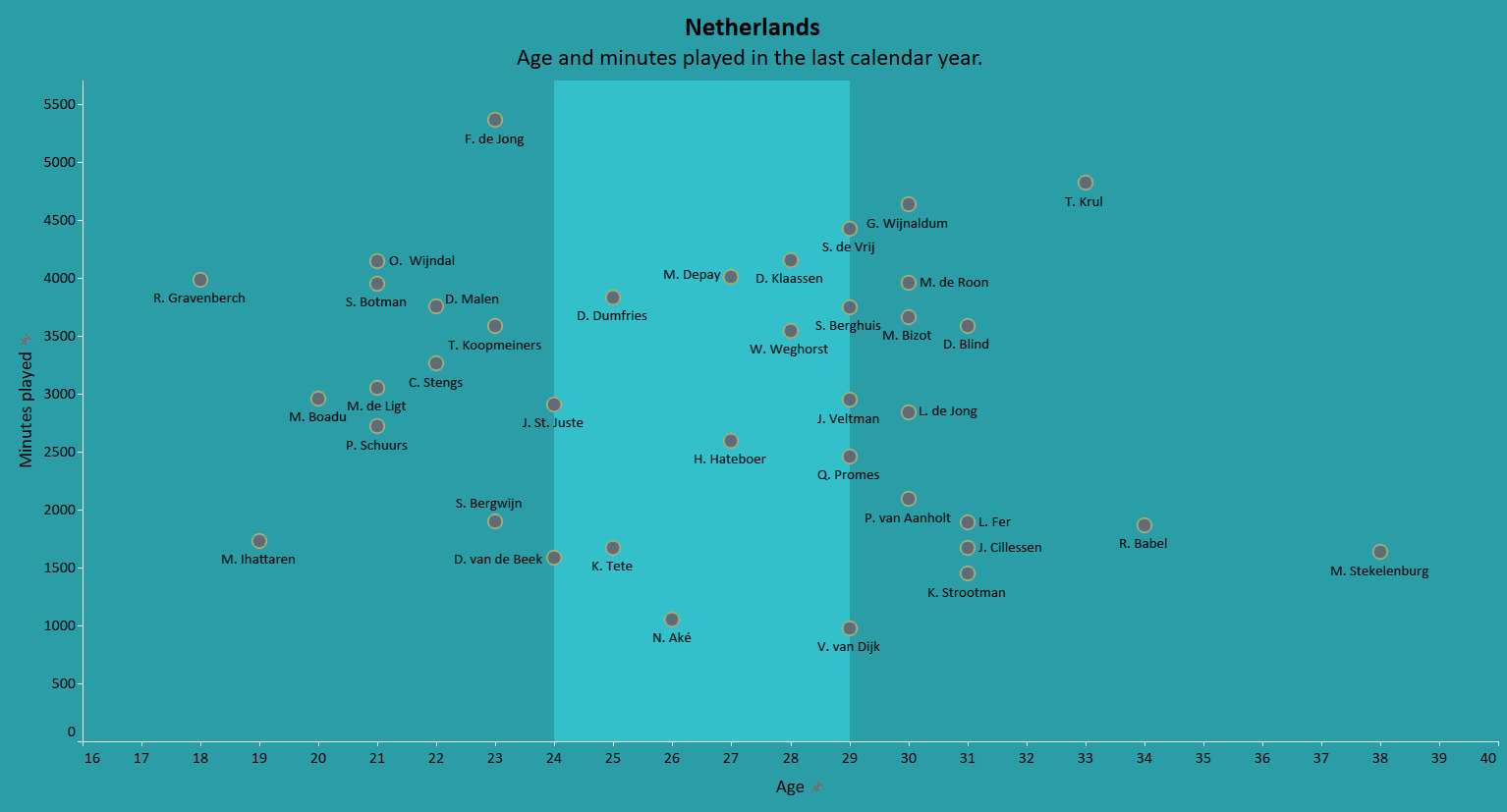
An immediate advantage for the side is that most of the key players are within the peak and youth age. Wijndal, Frenkie de Jong, and de Ligt are all expected to be consistent starters throughout the competition and these three are still classified as youth players, as they are aged 23 and below.
Depay, Dumfries, de Vrij, and Berghuis are currently in the peak age ranges, between 24 and 29, with the latter two just about in this range. This effectively means that seven out of the starting eleven are within the youth and peak age, which does bode well for the future of the side as well, going beyond the Euros and heading into the World Cup. Talents such as Ryan Gravenberch, Sven Botman, and Donyell Malen are also still below 23 and have played significant minutes, meaning the side have a rich pool of talents with decent experience coming up as well.
The more experienced players such as Wijnaldum, de Roon, Luuk de Jong, and Cillessen are also expected to be key parts of the squad at the Euros, but apart from them, not many players in this age range have significant minutes. Backup goalkeepers mainly feature highly for minutes, with the side having an aged squadron for this position as mentioned earlier. Apart from them, Blind receives the most minutes having played his role as a center-back for Ajax.
Overall, the squad is placed pretty well in terms of age and there does not seem to be a threat of a core group retiring all at once, which is surely good for the long-term future of the national side.
ATTACKING PHASE
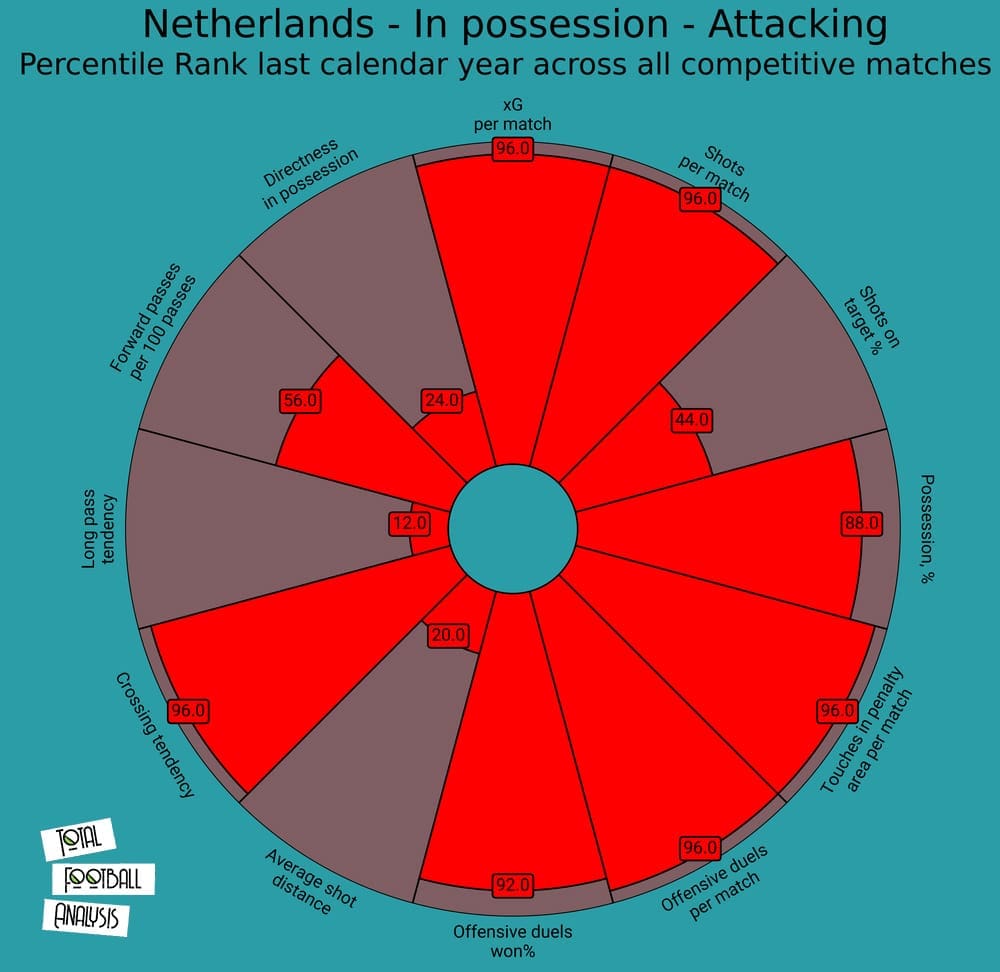
Looking at the percentile rank of the Netherlands side across attacking metrics, we immediately see how highly they rank for expected goals per game. However, this is not down to the quality of the shots taken but is mainly due to the large amounts of shots that the side takes, with them ranking in the 96th percentile for the volume of shots per game. Unfortunately, the conversion rate has been poor for the side, with the side only in the 44th percentile for shots on target. A lot of the shots have been suboptimal, with the side not really able to create a good number of clear-cut chances for themselves and this has perhaps been the major concern under de Boer. Despite scoring seven against Gibraltar, the side has shown that they can dominate lesser sides but when posed with a stronger defense, they appear to falter, as they did in a 4-2 loss against Turkey.
We also see that the side likes to play in possession, usually against ‘smaller’ sides, but their high ranking of touches in the penalty area per game is perhaps inflated owing to their high crossing tendency. There is perhaps an overreliance on crosses in order to score goals under de Boer and this could be a major reason for the downfall for the Oranje this summer. Their attacks are easily repelled by sides capable of defending deep, forcing them to commit more players forward and in turn leaving them vulnerable at the back. The Netherlands also ranks low for average shot distance, meaning they take most of their shots closer to the goal but again, dependence on crosses means that these shots are not clear goal-scoring chances. There is also a tendency for the side to try and overcomplicate their attacks and try to work their way too close to the goal, when they may have found room for a shot a bit further away.
Apart from this though, the side ranks highly for offensive duels and has a good success rate as well, meaning that they are good on the ball and can beat their man. There is also a clear tendency to build up the attack from the back, rather than rely just on long balls and we see this with their lower rankings for long pass tendency and directness in possession. However, an issue with this seems to be the pace of the build-up with the low ranking for forward passes showing that the side may not necessarily move the ball forward very often and are left with less threatening rotations of the ball towards the back. This allows the opposition to fall back and settle into a solid structure in order to defend better, once again making it difficult for the Netherlands to be truly threatening in attack.
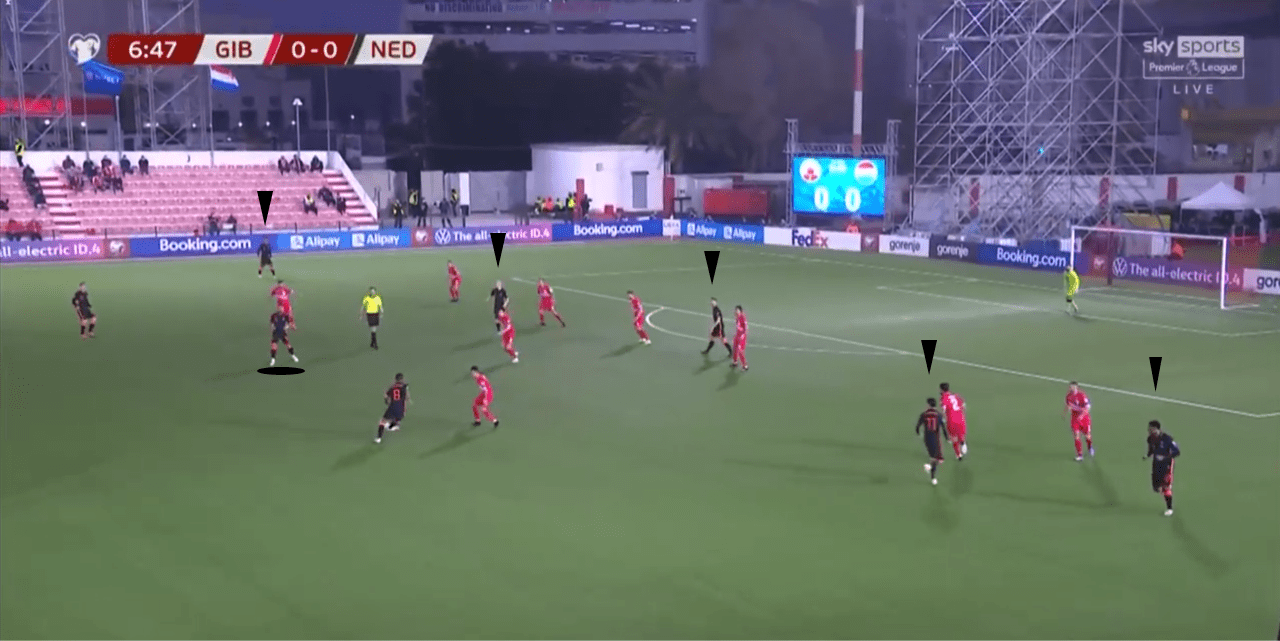
In terms of tactics, there is a slight variation that we will see throughout that depends on the midfield combination that de Boer plays. Depending on whether an attacking or defensive midfielder is played alongside Frenkie and Wijnaldum, Depay’s role changes accordingly. The aim of the Netherlands in possession is to get Depay central, but when an attacking midfielder plays, for example, Klaassen, then Depay will drop deeper into central midfield, allowing Klaassen to move forward and join an attacking line of five, with the full-backs pushing forward to provide width. Of course, Depay can also move into the front line when they look to play crosses into the box or pass their way in, but for the most part, he is given this free role just below the front line. This effectively leaves the Netherlands with a 2-3-5 formation in possession against ‘smaller’ sides.
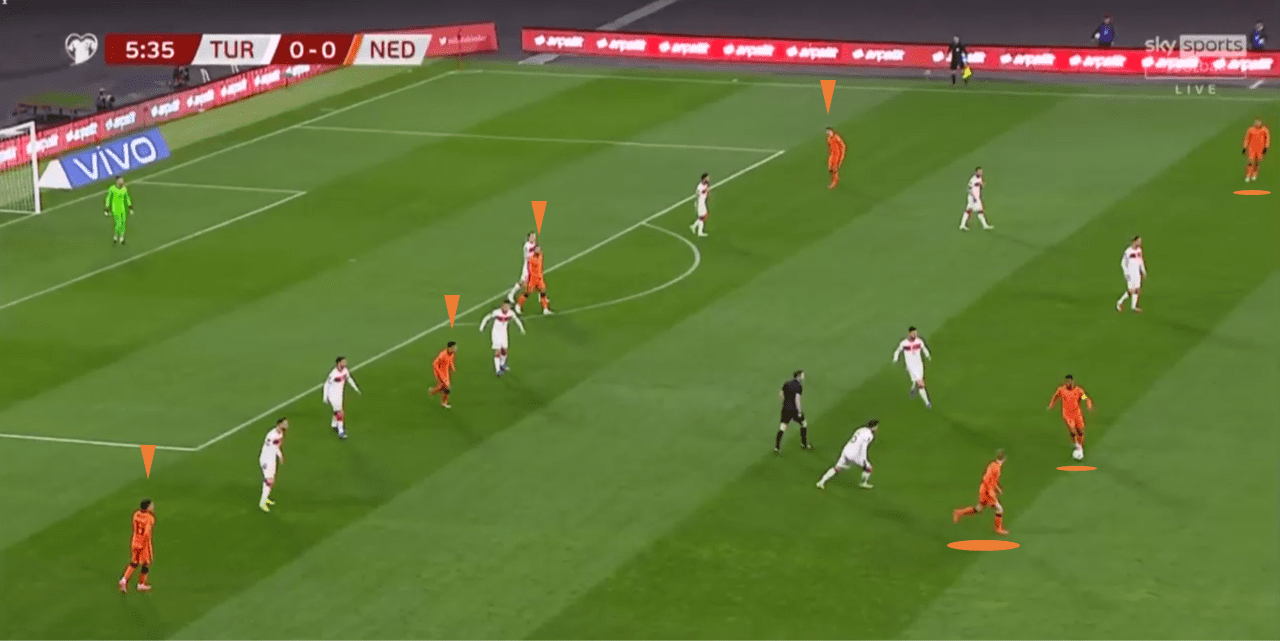
Against somewhat stronger opposition, de Boer does not play the attacking midfielder and in this case, Depay moves centrally but stays in the front line. Essentially, he is a second center-forward in this phase, and the left-back acts as the winger and provides the width. To help with rotation in the midfield, the right-back does not join the front line but helps to provide width through the middle and allows the Netherlands to stretch the opposition midfield as well. This effectively creates a 3-3-4 formation with the defensive midfielder dropping into the backline.
DEFENSIVE PHASE
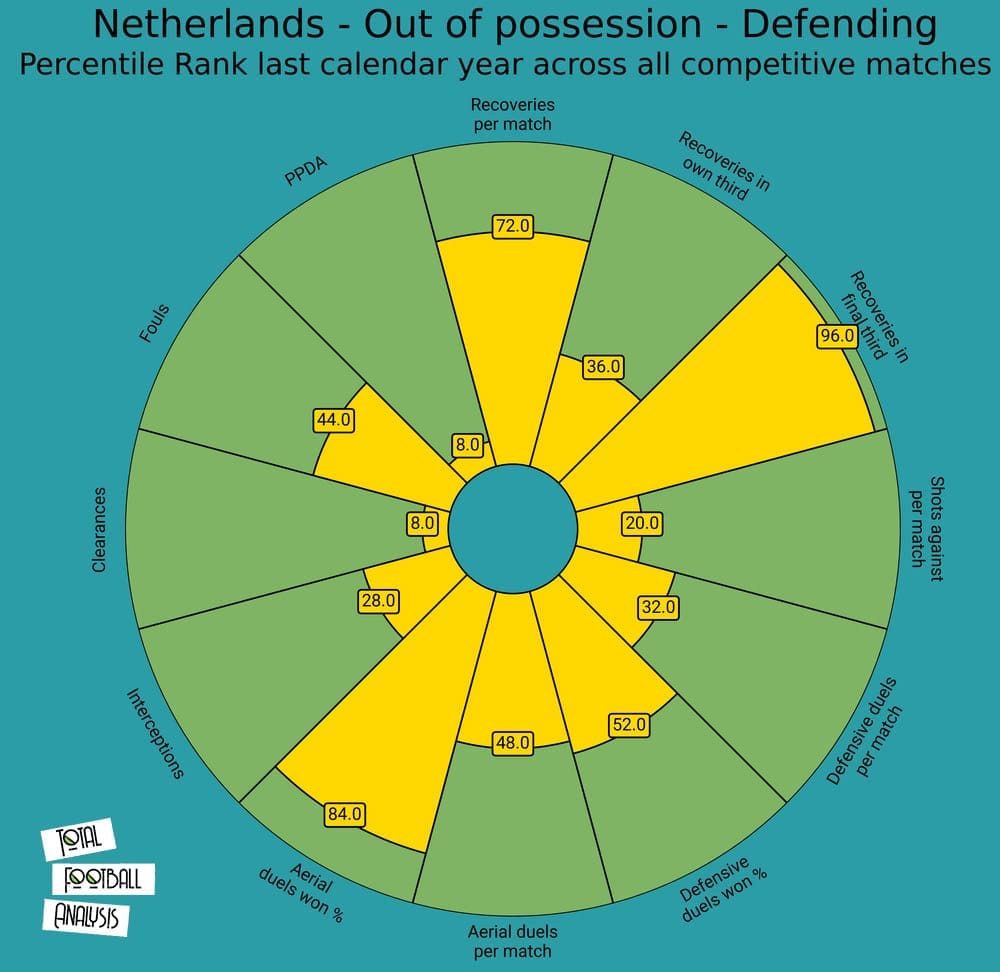
The defensive phase, however, does not look to be as good for de Boer’s side. With the side’s passes per defensive action (PPDA) ranking among the lowest, along with their high percentile rank for recoveries in the final third, it is clear that the Netherlands are a high pressing side. They engage in an active press when out of possession but this seems to be more effective in the opponent’s half. In their own half, they make fewer recoveries and in fact rank only in the 36th percentile. Interestingly, they face a low number of shots per game and rank only in the 32nd percentile for defensive duels per game. We see this for other defensive metrics too, with the side ranking lowly for interceptions and clearances as well.
This is mainly due to their style of play involving high-possession football. We saw earlier how highly the side ranked for possession and naturally when the opponent sees less of the ball, the side will have fewer defensive actions. We also see that they engage in fewer aerial duels per match, which is interesting considering the number of crosses that they play but their success rate from this is excellent, meaning that as of now, their quality in the air is not much of an issue.
These statistics, however, need to be taken with a pinch of salt. We mentioned how the side ranks lower for defensive actions owing to their domination of possession against ‘smaller’ sides but unfortunately when out of possession, they do present good chances for the opposition. The loss against Turkey once again is a prime example, with Netherlands conceding four goals from eight shots and five on target having had 66% of the possession. Against somewhat bigger sides, the possession is much more even and despite draws to Italy and Spain, the issues with defense could be a problem in the later stages of the tournament.
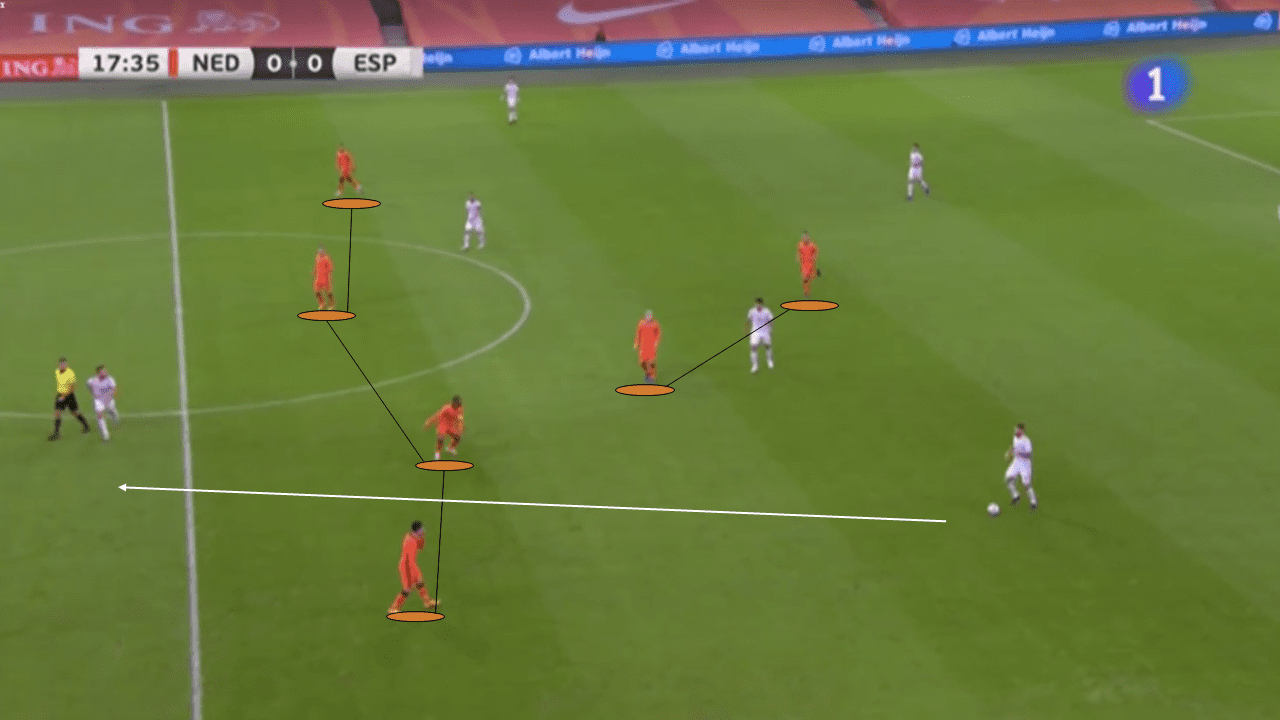
The Netherlands often settle into a 4-4-2 or 5-3-2 out of possession, usually with Depay in the front two. However, when the side uses an attacking midfielder, Depay drops into midfield and allows the attacking midfielder to pair up with the forward. In this case, it is a simple 4-4-2 with the wingers dropping into midfield. However, when Depay plays in the front two, which is how we expect the side to operate in the tournament, the defensive midfielder, either Frenkie or de Roon, will drop into the backline while Berghuis drops into midfield. Then, the left-back, Wijndal, would either operate as a wing-back or move forward into the midfield as a winger, allowing the side to shift into either a 5-3-2 or 4-4-2. This does not happen down the other flank though, as Berghuis does not join the front line of the press.
However, an issue with this pressing structure is that the Netherlands often offer space between the lines, as shown above. A major issue that they have faced is allowing players to receive the ball between the lines just ahead of the defense and turn and take on the backline. The players in the middle three or four are also too far ahead to recover in time and the side is often caught out in such situations.
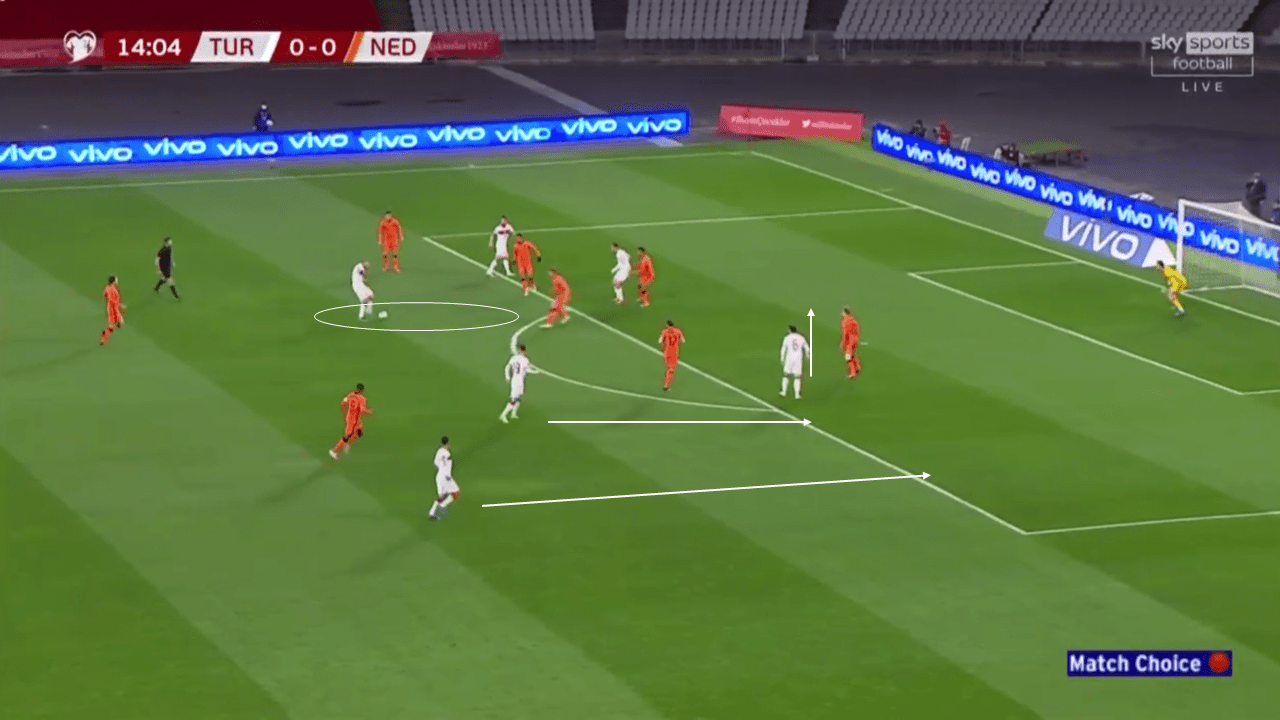
When defending deep in their own half, the absence of van Dijk is quite evident, with the side looking lackluster in defense. The defensive structure is messy, with Frenkie dropping back and the aim only to crowd the area close to the ball. Where van Dijk was good at reading the space and either tracking the runs of supporting players or engaging the ball carrier, the current backline struggles a bit in this area and are often indecisive in their movement. The image above shows how they neither close down the ball carrier nor track the runs of the supporting players and eventually, Turkey managed to score, with the player taking on the shot from distance. This does have to be sorted out heading into the tournament if the side is to have hope of going deep into the tournament.
TRANSITIONS
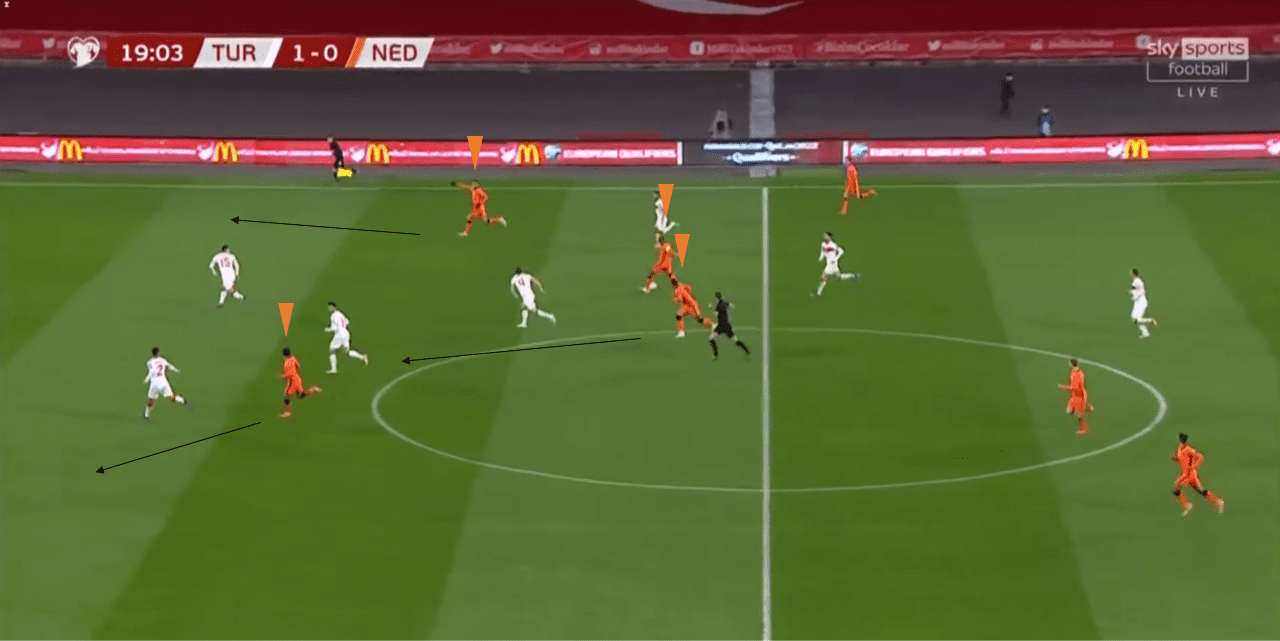
With Depay, Berghuis, and Malen among the ranks, the Netherlands certainly have pace on the counter and they look to do so with at least four players. Usually, the side will make use of the center-forward as an outlet from the back and his role is to hold up the ball before feeding it to a teammate on the run. By this time, the wingers in Depay and Berghuis are expected to provide the width and make runs to the wings but if they are not in a position to do so, then the full-backs make the runs instead. The center-forward also turns and makes a more central run while the ball carrier also looks to move towards the center, meaning he has two passes to the wings and one central option as well. The main idea is to quickly attack the spaces behind the opposition full-backs before squaring the ball into the box for the center-forward, and the earlier ball-carrier, to meet.
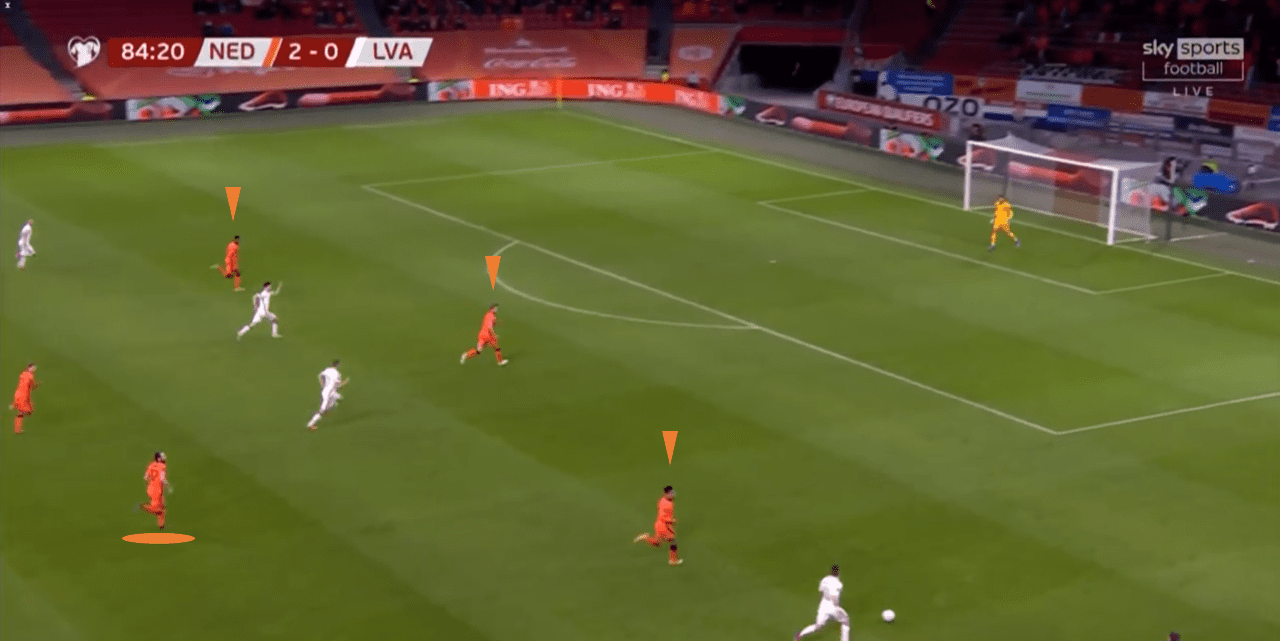
In the defensive transition, the onus is on the full-backs to drop back quickly in order to prevent leaving large spaces for just the center-backs to cover. One center-back, Blind in the above case, moves forward to engage the opposition ball-carrier and effectively blocks off the central spaces, meaning that he has to feed his teammate out wide. This also buys time for the full-backs to drop back but understandably, this is a risky tactic. Should Blind, or whichever center-back, be beaten in a 1v1, the opposition could easily outnumber the remaining defenders and create an excellent scoring opportunity.
When the Netherlands use a defensive midfielder, they would have him for support through the middle as well but against Latvia above, the side used an attacking midfielder and it meant that Frenkie had to drop back in order to support the defense. This is of course a problem as he would have to cover large spaces in midfield quickly to get back and may not always be able to recover in time. This means that there is effectively a 3-2 formation at the back as shown above and the side would have to ensure that they can get the lines as close to each other as possible to prevent a simple pass from exposing them. Of course, with a defensive midfielder, it is a formation of 4-2 at the back and allows for greater stability.
FORWARDS
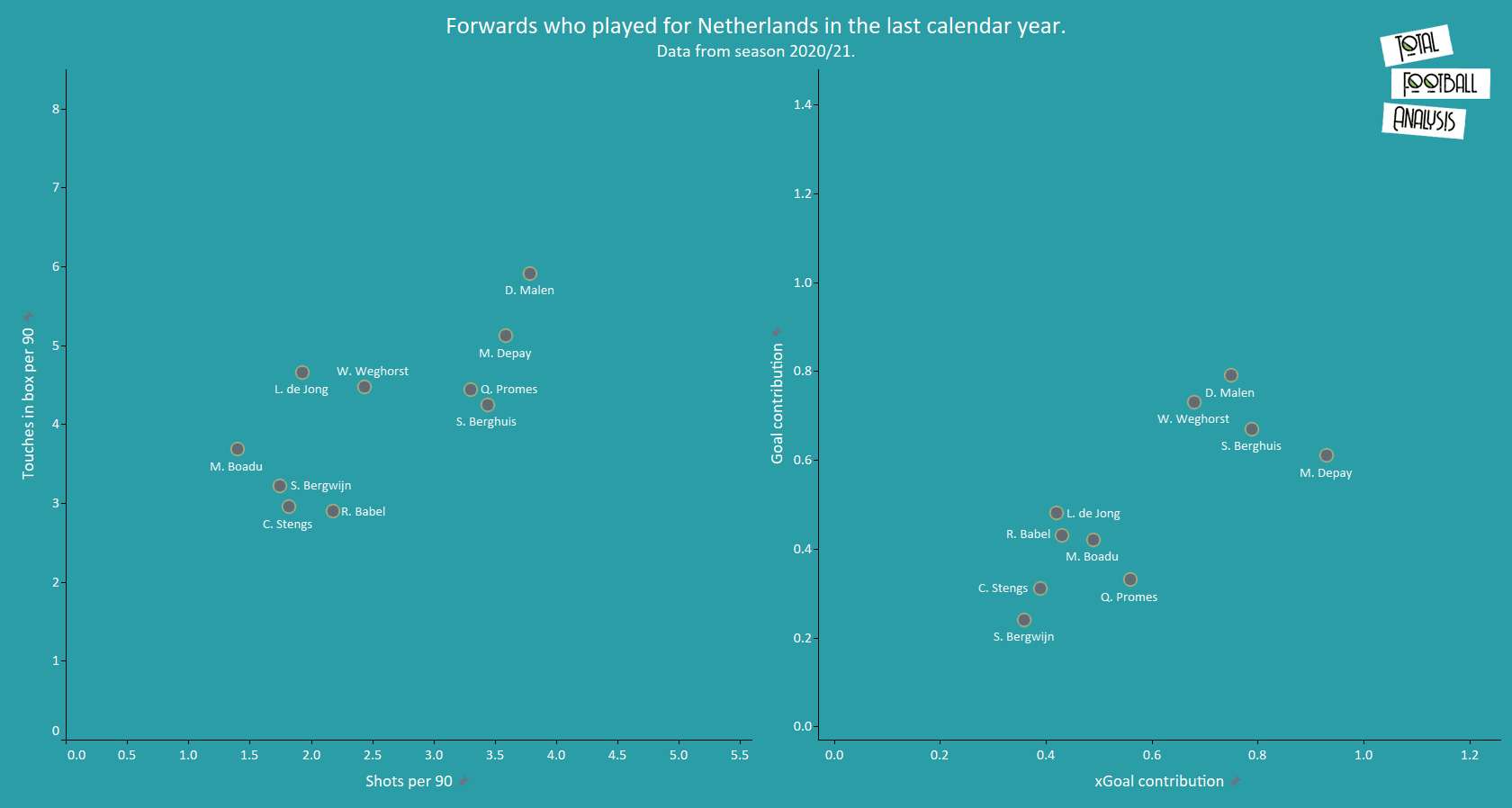
Looking at the forwards in the side, Malen is among the most threatening of the group, along with Weghorst, but we still believe that neither would be the side’s leading forward in the tournament and the man that we believe will lead the line, Luuk de Jong, fares pretty decently as well. Weghorst probably should still challenge for a spot in the starting eleven, with fans crying out for the same and the fact that he can fit de Boer’s style of play, but with the manager so far unwilling to do so, it would be a big deal (maybe even good) should he find himself a starter at the tournament. Apart from them, we see Depay and Berghuis fare at the top as well, with both of them quality players and captains of their respective clubs as well. The rest do not seem to really match up, with only Quincy Promes coming somewhat close and returning to the squad for the first time since a run-in with the police in December where he was arrested for alleged involvement in a stabbing. We do believe he has dropped well down the pecking order for de Boer and is highly unlikely to be a starter.
MIDFIELDERS
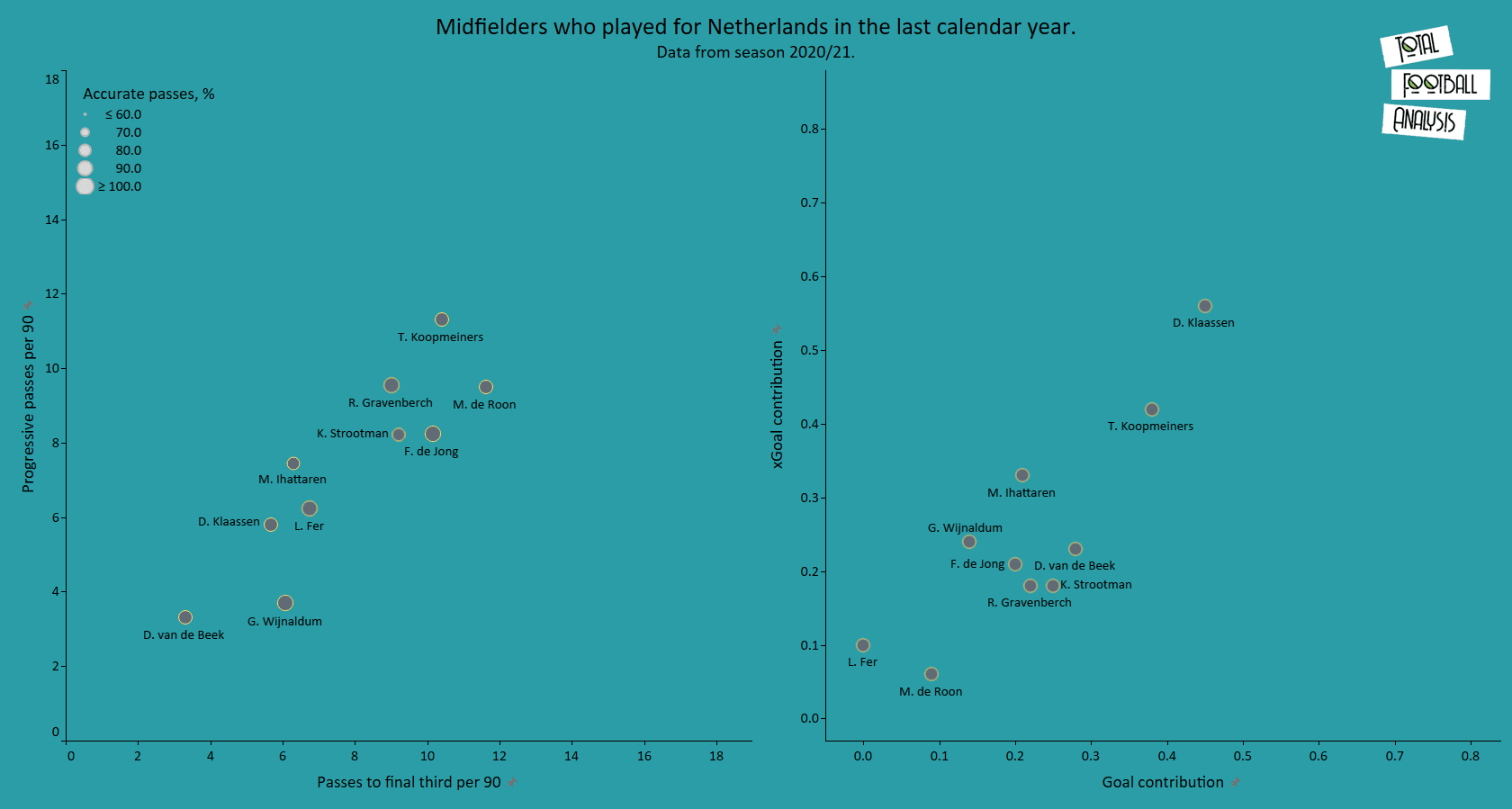
Moving on to the midfielders, Teun Koopmeiners, the 23-year-old captain of AZ Alkmaar, appears to be a standout performer this season, making the greatest number of progressive passes per 90 and the second-highest passes to the final third per 90. He also ranks second for expected and actual goal contribution among this list and statistically seems a no-brainer. The confirmed spots in the starting line-up, however, go to Frenkie de Jong and Wijnaldum, with the latter being one of the more experienced members and the captain of the squad. This does somewhat excuse his poor passing statistics but Wijnaldum does rank fourth-highest for expected goal contributions and de Boer will be relying on his leadership and experience to take the side far into the tournament. The battle for the remaining spot in midfield, we feel, is between Klaassen and de Roon as we mentioned earlier. While Klaassen ranks highest for expected and actual goal contribution, de Roon plays the highest passes to the final third per 90 and third most progressive passes per 90. Of course, we are essentially comparing to different types of midfielders here, but we feel this is precisely the decision that de Boer has to make. Should he go for an attacking set-up against a weaker side, he could field Klaassen to aid the attack but deeper into the tournament, we believe de Roon will be the key to providing defensive stability for the Netherlands.
With these four players in the squad, Donny van de Beek and Ryan Gravenberch join them despite the former not playing much since his move from Ajax to Manchester United. He still has been a crucial part of the national side and impressed in the last round of fixtures, also showing good performances coming off the bench, and is a handy option for de Boer to have. As for Gravenberch, he has been a key part of the title-winning Ajax side at just 18 years of age and is one of Europe’s brightest prospects. His passing statistics show that as well and he could really make his mark on the tournament if given the chance but we feel that he would probably be used as an option off the bench if needed and that this time around it would be about gaining the experience of an international tournament for the youngster.
DEFENDERS
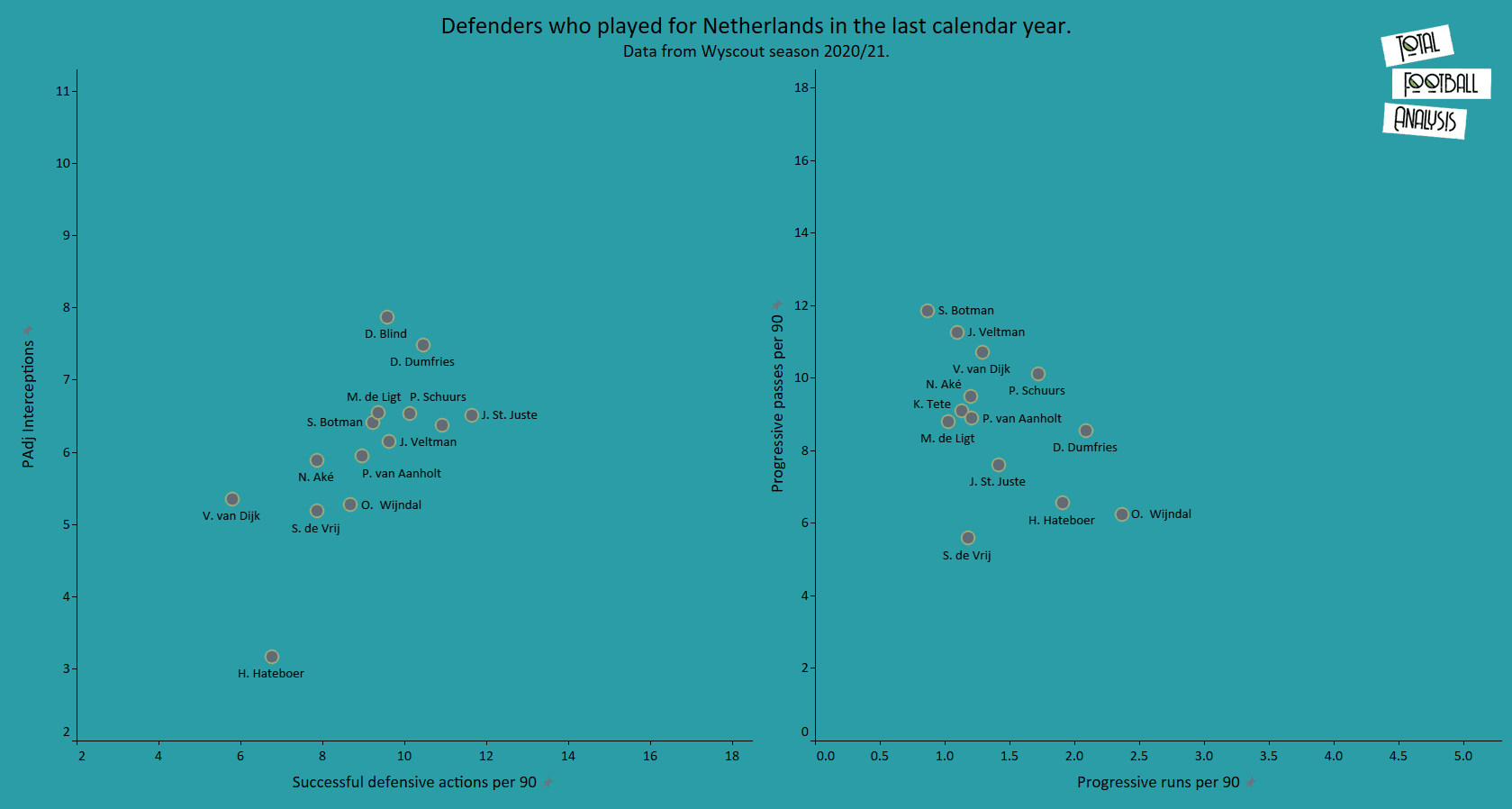
Now, when looking at the backline, it is important to remember that van Dijk misses out and Blind could still be carrying an injury and we would have to look at the other options at center-back. At right-back though, Dumfries seems clear of the rest, ranking second-highest for Possession Adjusted (PAdj) Interceptions per 90 and third for successful defensive actions per 90. While his performances for the national side have been erratic, Dumfries is PSV Eindhoven’s captain at 25 years of age and with a lack of better options, is pretty much guaranteed a start.
For the left-back spot, 21-year-old Wijndal has been the favorite to start despite his defensive statistics being on the lower side. However, he does top the lists for progressive runs per 90, which is good for a full-back, despite ranking lowly once again for progressive passes. Wijndal’s competition for the spot is Patrick van Aanholt but with the 21-year-old starting all three games in the previous run of fixtures, it seems like de Boer has chosen his left-back for the tournament.
Now, the center-back position is perhaps the most interesting part of this Netherlands squad with de Ligt, de Vrij, Jurrien Timber, Nathan Aké, and Joël Veltman to look at. Interestingly, the player that we expect to start, de Vrij, ranks lowest among the group for the defensive metrics. However, we mentioned that his experience would be important for the Dutch side this tournament and our other pick, de Ligt, is arguably the best choice statistically as well. He ranks third highest for Padj interceptions overall and third highest among center-backs for successful defensive actions as well. de Ligt’s presence in the line-up is important to de Boer’s side, especially in van Dijk’s absence, and would certainly be a leader in defense. As for Aké, he has struggled with injuries through the season and has faired pretty average statistically, so we do not expect him to be more than a squad player.
BEST PERFORMER
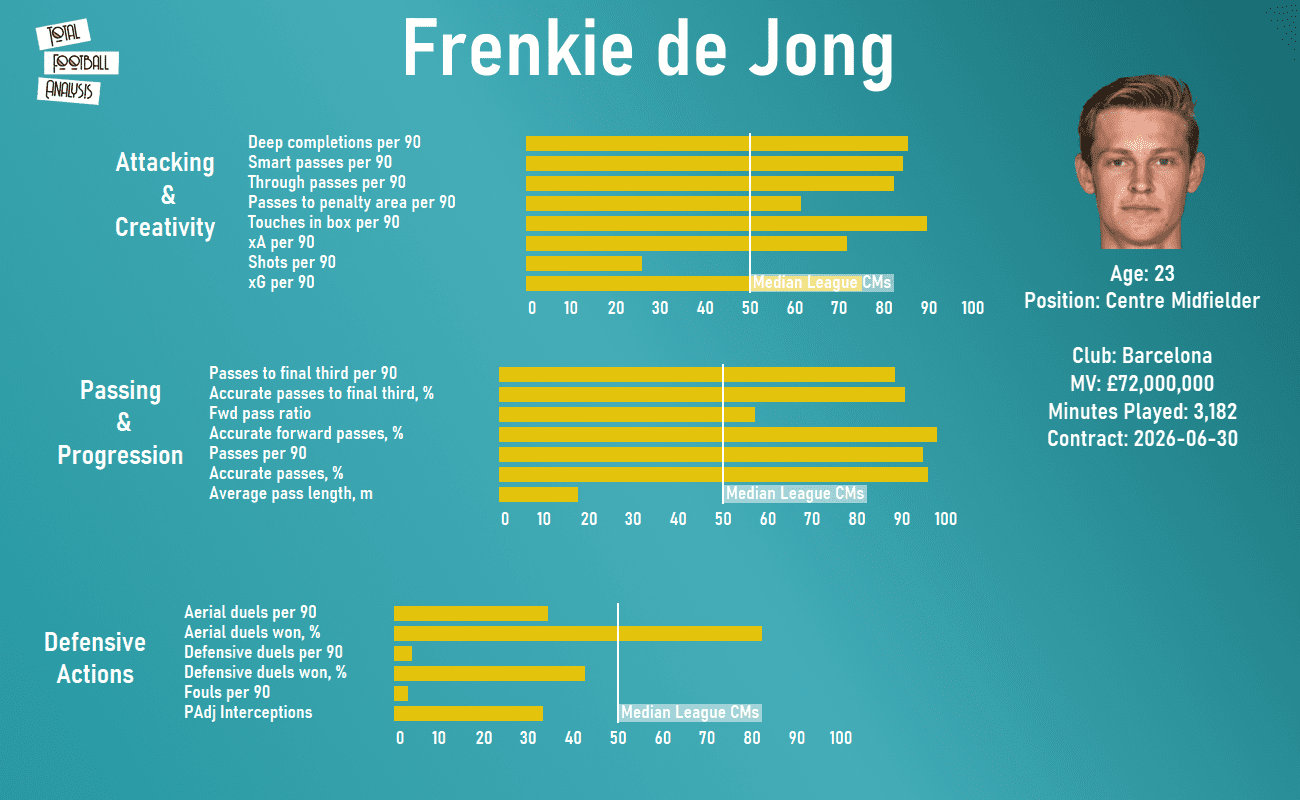
If the Netherlands are to go far in the tournament, Frenkie de Jong will surely have to fire on all cylinders and we believe he is key to the side’s performance. Along with Wijnaldum, he will be tasked with running the midfield and will be crucial in helping the side build up, linking the midfield with the attack. The Netherlands have had issues in attack and defense under de Boer and Frenkie will be key to preventing them from affecting the side at the Euros.
We see above that his passing and attacking ability has been excellent through the season, with the 23-year-old playing a crucial role in Barcelona’s late title charge. This will be very useful for the Netherlands with Frenkie having the freedom to move forward in possession and could probably often a new dimension apart from the usual tactics of crossing. In terms of defense, though, he does not rank as high and this might be a slight worry for the national side.
We mentioned earlier that he is sometimes deployed in a more defensive role in midfield and while there may not be an issue with him dropping into the defense in possession, he could be caught out should the side lose possession. We do, however, expect de Roon to be the player preferred for games with more defensive burden and hence this should not be much of an issue.
PREDICTIONS FOR THE TOURNAMENT
Netherlands find themselves in Group C, alongside Ukraine, Austria, and North Macedonia. Barring any huge upsets, we expect their quality to take them through to the knockouts and on paper, they should top their group as well. However, how far they go beyond that probably depends on who they face, with matchups against Portugal, Germany, or France all highly possible should they win their group.
Should they not top their group or avoid these teams, the fixture looks somewhat easier for the Round of 16 and potentially the Quarter Finals as well. This puts the side in the semis should the fixtures be favorable but we do not see them progressing any further than this. Their unpredictability, especially against strong opposition, means that we feel that practically the side could end up being knocked out anywhere between the Round of 16 and the Semi-Finals, but with their current setup and tactics, they are by no means favorites and we do not see them being surprise winners or finalists either.

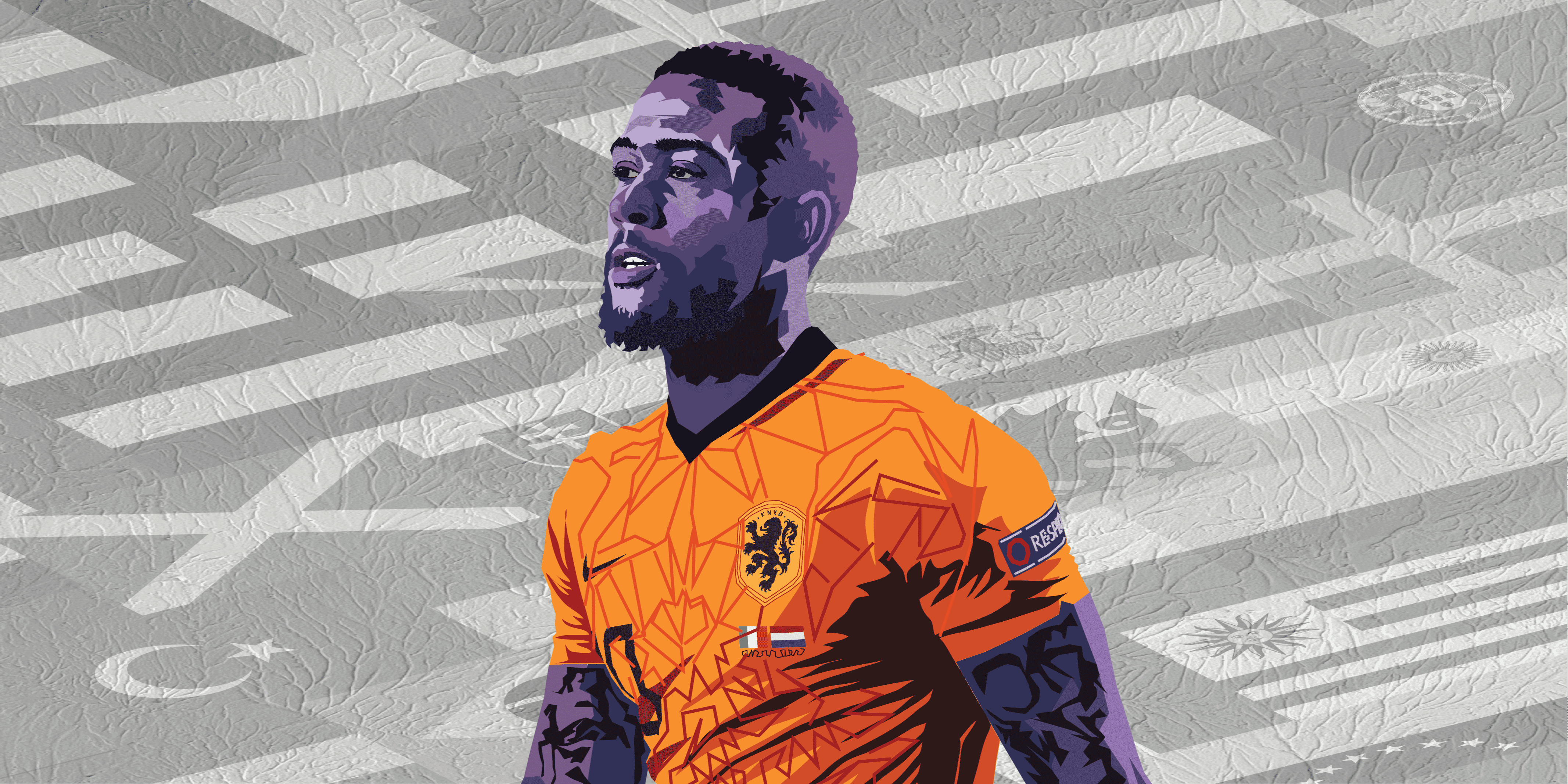



Comments